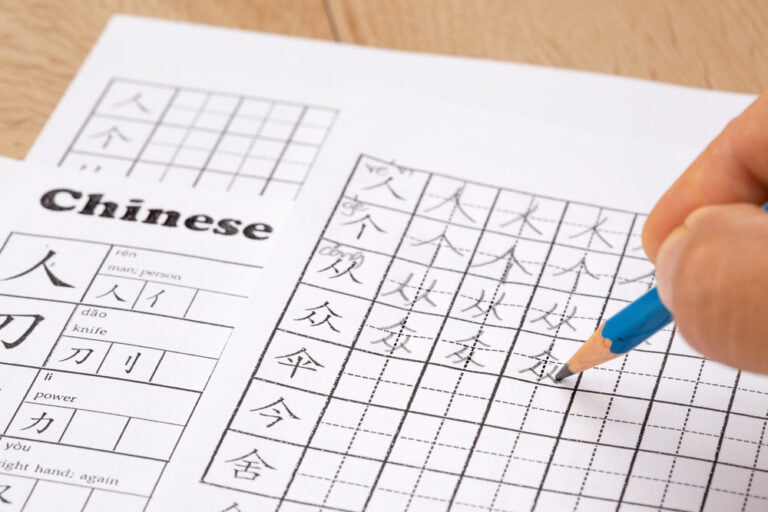The True Cost of Fluent Chinese (Way Less than You Think)

In today’s interconnected world, mastering a new language is more than just a cultural delight; it’s a strategic advantage. And among the many languages, Mandarin Chinese stands out.
Imagine the doors that open when you can converse fluently with over a billion people worldwide. From lucrative business opportunities to unique employment prospects, the benefits are undeniable.
But beyond these tangible perks lies something even more compelling — the societal prestige and personal confidence that come with mastering one of the world’s most challenging languages. Yes, being able to communicate in Mandarin does turn heads and can make you feel like a member of an elite group.
But what’s the real cost to learn Chinese? Is achieving fluency in Mandarin Chinese an attainable goal without breaking the bank or draining all your energy? In a world where learning resources are plentiful, understanding the best way to learn Chinese is crucial.
The journey to learning Mandarin Chinese is often shrouded in myths about the time and financial investment required. Through this article and its accompanying video, we’ll unveil the true cost of becoming fluent in Mandarin — and you might find it’s way less than you think.
Whether you’re a budding linguist, a business professional looking to expand your horizons, or simply a language enthusiast, this exploration into the real investment required to learn Mandarin will provide valuable insights and practical tips to guide you on your journey to fluency.
Defining fluency in Mandarin Chinese

Understanding the true journey to fluency in Mandarin begins with defining what fluency means. The word “fluency” encompasses a wide spectrum, and for the purposes of this discussion, we’ll focus on a very specific level of proficiency.
In the world of language learning, the Common European Framework of Reference for Languages (CEFR) is a widely recognized standard. It divides language proficiency into six levels: A1, A2, B1, B2, C1, and C2. For Mandarin Chinese, achieving a B2 level is often regarded as reaching real fluency.
What does B2 fluency entail? It’s the ability to interact with a degree of fluency and spontaneity that allows regular interaction with native speakers quite possible, without strain for either party. In simpler terms, think of it as being able to hold a conversation on various topics with ease, understanding most of what is said, and responding without causing confusion or discomfort.
Related Reading: The Build and Get Framework for Acquiring Mandarin Fluency
This level of proficiency in Chinese isn’t just about stringing sentences together. It’s about conveying ideas, sharing thoughts, and engaging in meaningful exchanges — essentially, participating fully in the linguistic and cultural nuances of the language.
Achieving B2 fluency in Mandarin is a significant milestone. It’s a level where the language opens up. You can enjoy Chinese films, read books, and follow discussions without the crutch of subtitles or translations.
It’s also where you start reaping the intellectual and cognitive benefits of bilingualism, like enhanced mental flexibility and improved problem-solving skills.
However, the path to this level of fluency in Mandarin Chinese is often misjudged. Traditional methods and popular beliefs suggest a one-size-fits-all approach, but the reality is far more nuanced.
The best way to learn Chinese effectively involves understanding your personal learning style, leveraging the right resources, and committing to a consistent, immersive learning experience.
So, the cost to learn Chinese, in terms of time, money, and effort, varies based on these factors. As we proceed, we’ll head deeper into these aspects, breaking down the realistic investment required to achieve B2 fluency in Mandarin Chinese and debunking common myths along the way.
Related Reading: The Awe of Language Learning — Master This Emotion to Reach Fluency
Time investment: Rethinking traditional estimates

When exploring the cost of learning Chinese, time is a pivotal factor. Traditional estimates suggest that achieving B2 fluency in Mandarin Chinese requires about 2,200 hours of study. However, this figure, often cited from the Foreign Service Institute (FSI), is based on a very specific learning context and method.
It’s crucial to understand that this number is not a one-size-fits-all, and for many learners, the journey might be quite different.
Firstly, the FSI’s methods are rooted in a classroom-based, textbook-heavy approach. While this might work for some, it’s not necessarily the best way to learn Chinese for everyone. It certainly wasn’t for me.
That kind of formal learning approach will often be monotonous and less effective for learners who thrive in more dynamic or interactive environments. Plus, the FSI’s figure doesn’t account for the additional hours needed for activities like homework, travel to and from classes, or the invaluable immersive practice outside the classroom.
When these factors are considered, the actual time investment can easily exceed the estimated 2,200 hours.
What’s more, every learner’s journey is unique. Some may progress faster due to previous language learning experience, natural aptitude, or more efficient study methods. Others might find themselves needing more time to grapple with the intricacies of Mandarin, a language distinct in its tones and characters from most Western languages.
Consequently, a more realistic estimate might range between 3,500 to 5,000 hours of dedicated learning.
The learning process also involves a period of trial and error, where learners experiment with different methods and resources to find what works best for them. This exploratory phase is crucial in the journey to fluency but often extends the time commitment.
Understanding this variability in time investment is key to setting realistic expectations and strategies for learning Mandarin Chinese. It’s not merely about clocking hours; it’s about engaging with the language in a way that is effective and enjoyable for you.
This means shifting the focus from a rigid hour count to a more personalized approach, emphasizing that the path to fluency is less about the number of hours spent and more about the quality and consistency of your learning experiences.
Related Reading: Do You Need to Learn Chinese to Visit China?
Financial costs: University, private tutoring, and language apps

A crucial aspect of understanding the cost to learn Chinese is the financial investment involved. Learning Mandarin Chinese can involve various expenses, ranging from university courses to language learning apps, each with pros and cons.
University courses
For those considering a formal education route, university courses can be a significant investment. In the United States, for example, a degree in Chinese might cost upwards of $100,000.
Even in China, where tuition fees are generally lower, the total cost, including living expenses, can quickly add up. The problem is that the effectiveness of university programs in achieving fluency can vary greatly. While they offer structured learning and immersion opportunities, they may not always provide the most efficient path to B2 fluency.
Private tutoring
Another popular option is private tutoring, which is available through platforms like iTalki or HelloTalk. Tutoring can offer personalized attention and tailored lessons, making it one of the best ways to learn Chinese for many learners.
The cost can range from affordable to premium, depending on the tutor’s experience and qualifications. A rough estimate for reaching B2 fluency through private tutoring could be around $5,000, assuming an average rate of $20 per hour over 250 hours. This method can save time and offer a more practical speaking experience compared to traditional classroom learning.
Language learning apps and online courses
In the digital age, language apps like Duolingo, Hello Chinese, and Rosetta Stone have become popular tools. These platforms offer flexibility and convenience, often at a lower cost than traditional learning methods.
However, while they’re great for beginners or for supplementing other learning methods, they may not be sufficient on their own to achieve B2 fluency. Online courses specifically designed for Mandarin learning, such as Mandarin Blueprint, can be more comprehensive, though they also come with varying price tags.
It’s important to note that while all of these resources have associated costs, they are investments in your language learning journey. The choice between them should be based on your learning style, goals, and budget.
The financial cost of learning Chinese isn’t just about the price of the resources. It’s also about their value in terms of time saved and effectiveness in achieving fluency. Balancing these factors is key to determining the most cost-effective approach for you.
Related Reading: Debunked: Common Myths about Learning Chinese
Energy and effort: The overlooked currency in learning Mandarin

While time and money are often the primary focus when considering the cost to learn Chinese, the energy and effort expended are equally important. Achieving fluency in Mandarin Chinese isn’t just a financial or chronological commitment; it’s a mental and emotional one as well.
Traditional classroom challenges
Traditional classroom settings, whether at a university or a language institute, often require a considerable amount of energy. This isn’t just about attending classes; it’s about engaging with potentially dry and uninspiring content. For many learners, these methods can lead to frustration and burnout, especially if the teaching style doesn’t align with their learning preferences.
Self-directed learning and motivation
For those opting for self-directed learning methods, including online courses and language apps, the challenge often lies in maintaining motivation and discipline. Without the structure of a formal class, it can be easy to lose focus or feel overwhelmed by the sheer volume and complexity of the Mandarin language. This path requires a significant amount of energy, not just in studying but in planning and self-regulating the learning process.
Balancing efficiency and enjoyment
The key to sustainable learning is finding a balance between efficient methods and those that keep you engaged and motivated. Interactive tools, such as language exchange apps or immersion through media (like movies, Chinese TV shows, and podcasts), can make the learning process more enjoyable.
While these methods might not replace structured learning, they can significantly reduce the energy drain and make the journey to fluency more pleasurable.
The mental aspect
Learning Mandarin isn’t just a physical task of attending classes or clicking through an app. It’s a cognitive exercise that involves understanding complex Chinese characters, grasping tonal nuances, and familiarizing oneself with a vastly different grammar structure.
The mental energy required for these tasks is substantial, and acknowledging this is crucial in planning your learning journey.
So, when you’re considering the best way to learn Chinese, it’s important to factor in the mental and emotional investment required. Each learner will have a different threshold for what they find enjoyable or draining. Tailoring your learning approach to balance efficiency with enjoyment is essential in managing the energy and effort required to achieve fluency in Mandarin Chinese.
Related Reading: Is Chinese Hard to Learn?
The efficient path to fluency in Mandarin Chinese

After considering the time, financial, and energy investments, it’s crucial to explore the most efficient paths to achieving fluency in Mandarin. The ultimate goal is to find the best way to learn Chinese, aligning with your personal needs and circumstances. Let’s outline the best strategies that blend effectiveness with practicality.
- Integrating a multi-faceted approach: Rather than relying on a single method, combine various learning tools and techniques. This could mean supplementing university courses with language apps or combining private tutoring with self-study using online resources. Such an approach can optimize your learning by covering different aspects of the language — from formal grammar to conversational skills.
- Embracing technology and online resources: In today’s digital era, there are numerous online resources available for learning Mandarin Chinese. From interactive apps like Hello Chinese to comprehensive online courses, these resources can provide flexible and engaging learning experiences. They also often come with communities for support and motivation, which can significantly enhance the learning process.
- Customized learning paths: Personalization is key in language learning. Tailor your study plan based on your learning style, goals, and pace. This could mean focusing more on speaking and listening for conversational fluency or delving deep into reading Chinese and writing if your interest lies in literature or business communication in Chinese.
- Immersive learning experiences: Immerse yourself in the language as much as possible. This can be done by watching Chinese movies, listening to Chinese music, participating in language exchange programs, or even traveling to Mandarin-speaking regions. Immersion isn’t just about language exposure; it’s about understanding the cultural context, which is invaluable for true fluency.
- Regular practice and consistency: Consistency trumps intensity in language learning. Regular, even if shorter, study sessions are more effective than infrequent, long sessions. Integrating Chinese into your daily routine, like listening to a Mandarin podcast during your commute, can be a practical way to ensure consistent practice.
- Setting realistic and achievable goals: Set short-term and long-term goals for your Mandarin learning journey. These goals should be specific, measurable, achievable, relevant, and time-bound (SMART). Celebrating small milestones can keep you motivated and on track.
The reality is that the best way to learn Chinese efficiently involves a combination of methods tailored to your personal preferences and lifestyle. It’s about balancing structured learning with immersive experiences, leveraging technology, and maintaining consistent practice.
By adopting these strategies, the journey to Mandarin fluency becomes not only more efficient but also more enjoyable and rewarding.
Related Reading: The Surprising Benefits of Learning a Language from a Non-Native Speaker
Unlock the secrets to Mandarin fluency
As we wrap up our exploration into the true cost of achieving fluency in Mandarin Chinese, it’s clear that the journey is less daunting and more attainable than many might think.
Understanding the best way to learn Chinese doesn’t just involve assessing financial or time investments, though. It’s about aligning learning strategies with your personal goals, lifestyle, and preferences. The road to fluency in Mandarin is a blend of dedication, smart choices, and enjoyment of the learning process itself.
You’ve seen how mastering Mandarin Chinese opens up a world of opportunities and enhances your cognitive abilities. The prestige and personal satisfaction that come with fluency are within your reach.
Imagine being able to converse effortlessly in Mandarin, appreciate Chinese cinema without subtitles, and navigate business environments with ease. This isn’t just a dream; it’s a goal that’s entirely achievable with the right approach.
Ready to take the next step in your Mandarin learning journey? We have the perfect tool for you. With our FREE Mandarin Fluency Scorecard, you can get a comprehensive assessment of your current Chinese skills in under a minute. This isn’t a basic evaluation; it’s a gateway to a customized guide tailored to propel you toward fluency.
What’s in it for you? The Mandarin Fluency Scorecard will quickly identify your personal weaknesses and barriers to fluency. It provides you with a clear roadmap based on your current level, highlighting immediate action steps to enhance your learning experience.
And the best part? It’s completely FREE, and the entire process takes less than 60 seconds. This is your opportunity to gain valuable insights and take a significant leap toward mastering Mandarin.
Don’t let this chance slip away. Embrace your language learning journey with confidence and clarity.
Start on this exciting journey and discover how you can achieve Mandarin fluency faster and easier than you ever thought possible. Your path to becoming a fluent Mandarin speaker starts here.








